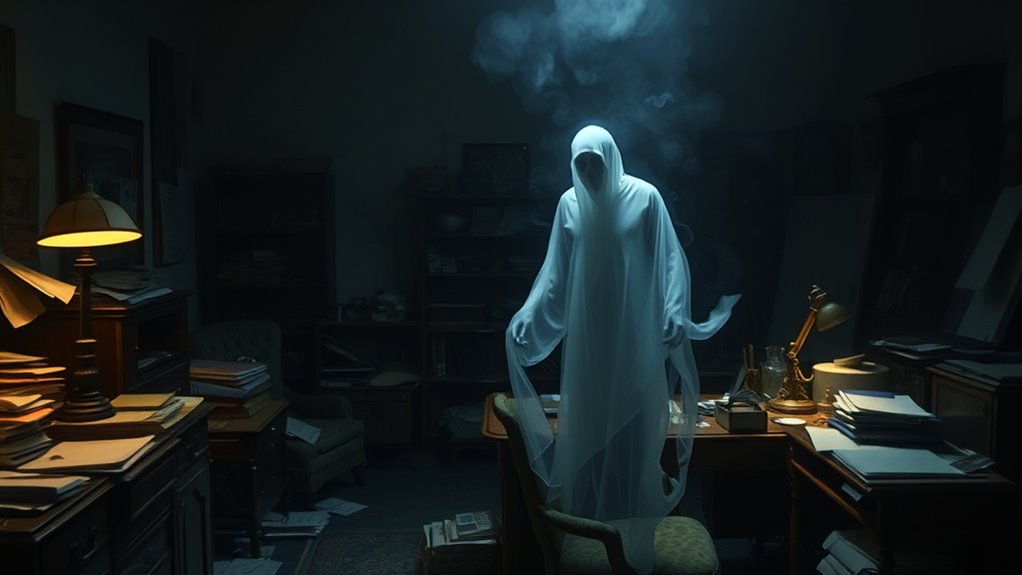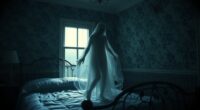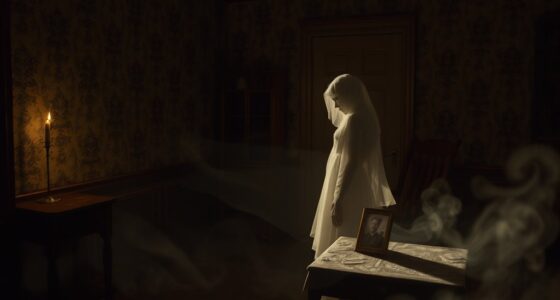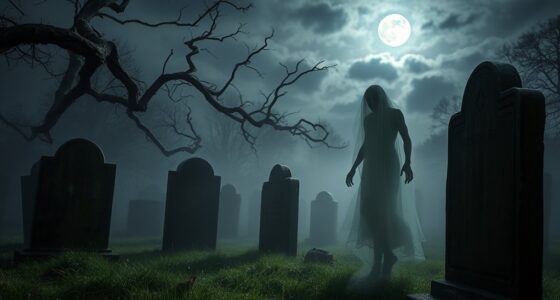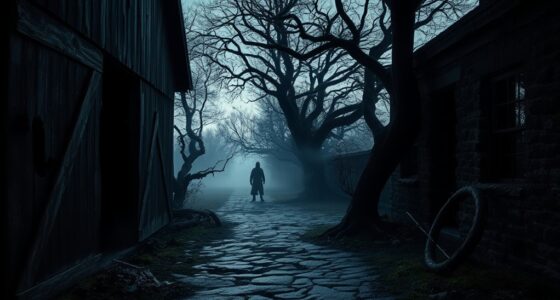The Rosenheim poltergeist case involves unexplained phenomena at a Bavarian office, where files move, lights flicker, and objects shift mysteriously. Employees documented their experiences, capturing audio and photos that support the activity. Investigators found no environmental or psychological explanations, confirming active, unexplained disturbances. Theories suggest supernatural influences or complex mind-environment interactions, sparking ongoing debates. If you want to uncover how this case challenged science and continues to influence perceptions, there’s more to explore.
Key Takeaways
- The Rosenheim Poltergeist involved unexplained activity in a furniture shop, including moving objects and electrical disturbances.
- Documentation included photos, audio recordings, and employee reports detailing escalating supernatural phenomena.
- Investigations ruled out natural causes like electrical issues, confirming the activity as consistent with poltergeist behavior.
- The case prompted theories ranging from psychological influences to environmental electromagnetic interference.
- The Rosenheim case remains a significant example in paranormal research, demonstrating unexplained phenomena with substantial evidence.
The Setting and Initial Unexplained Events
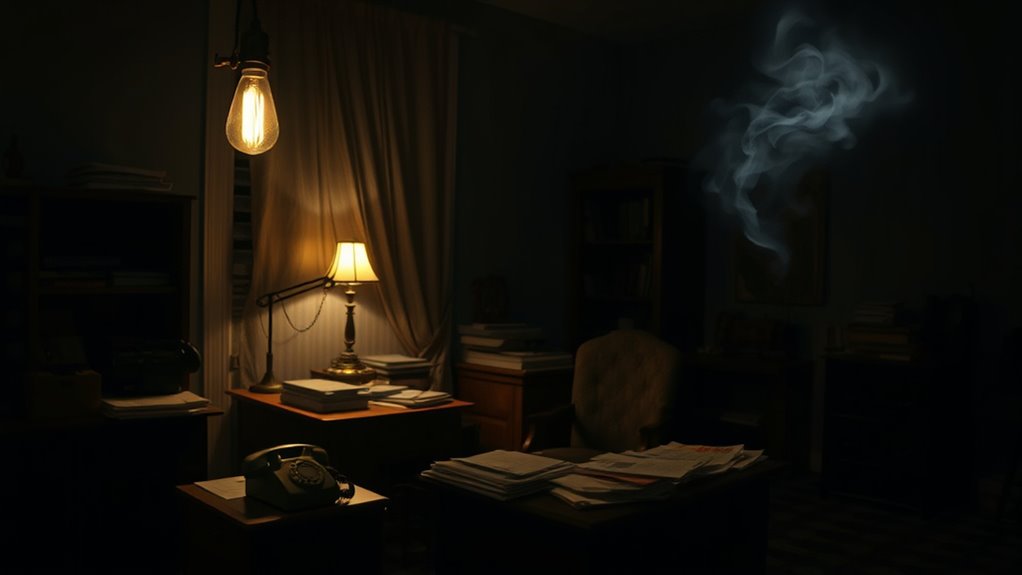
The Rosenheim Poltergeist saga begins in a small, bustling office where employees start noticing strange occurrences that defy explanation. It feels like a house haunting, but this supernatural activity happens right in their workspace. Files move on their own, lights flicker without reason, and objects seem to shift mysteriously. At first, you might dismiss it as technical glitches or coincidence, but the frequency and intensity grow. The unsettling events create a tense atmosphere, leaving everyone on edge. No logical explanation fits, fueling fears of a supernatural presence. The initial unexplained events signal the start of something far more disturbing, as the office becomes a hotspot for unexplained phenomena that challenge your understanding of reality. Recognizing unexplained phenomena can be vital in distinguishing between natural causes and potential security concerns in modern environments. Additionally, cybersecurity measures could be crucial in understanding or protecting against such mysterious disturbances.
Witness Accounts and Documentation
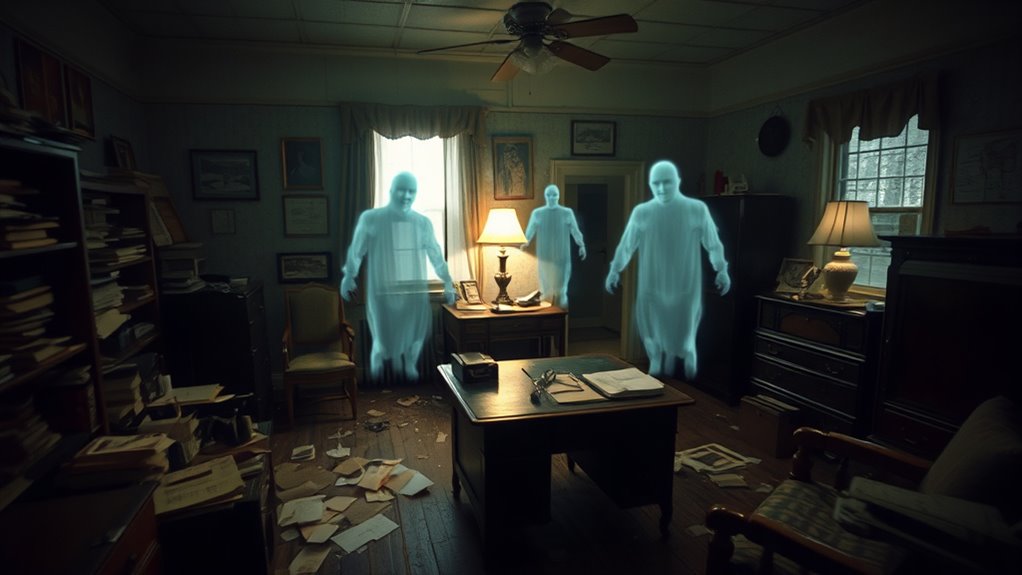
As the unexplained events intensify, employees and witnesses begin to document their experiences, providing a detailed record of the phenomena. These accounts capture the strange occurrences of paranormal activity—objects moving unexpectedly, mysterious noises, and sudden temperature drops. Witness testimonies offer valuable insight into the events, often describing feelings of fear and confusion. During this period, documentation becomes more systematic, with written reports, photographs, and even audio recordings. The historical context adds weight to these accounts, as they reflect the atmosphere of skepticism and curiosity prevalent at the time. These firsthand observations serve as pivotal evidence, helping to establish a timeline of events and offering a foundation for further investigation into the poltergeist activity at Rosenheim.
Investigation Efforts and Findings
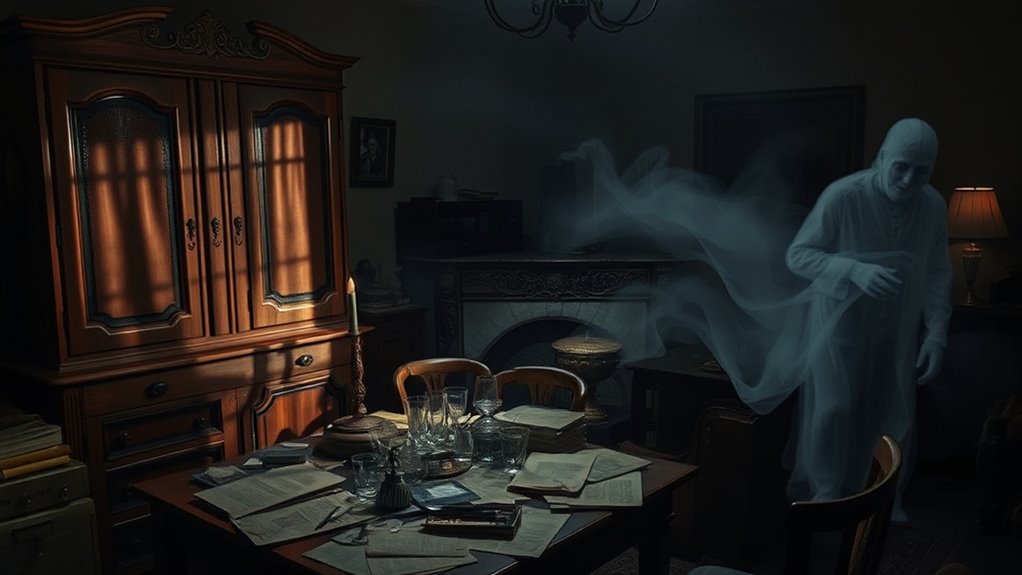
Investigation efforts at Rosenheim intensified as experts examined the mounting witness reports and documented phenomena. Using various investigative techniques, they aimed to understand the poltergeist phenomena affecting the home. Sensors and recording devices captured unexplained sounds and movements, while visual inspections revealed objects moving without human contact. Psychologists and parapsychologists interviewed witnesses and analyzed patterns in the disturbances, seeking natural or psychological explanations. The team also ruled out electrical malfunctions and environmental factors that could cause similar effects. Their findings confirmed the presence of active, unexplained phenomena consistent with classic poltergeist activity. Despite thorough investigations, no definitive scientific explanation emerged, fueling ongoing debate about the true nature of the disturbances and the potential influence of paranormal forces. Developmental factors and environmental influences were also considered to determine if they played a role in the phenomena. Additionally, researchers considered mental wellbeing indices to assess whether psychological stress might have contributed to the reported disturbances. Incorporating scientific methods enhanced the credibility of the investigation and helped differentiate genuine phenomena from potential hoaxes or misinterpretations. Furthermore, understanding legal resources and the importance of expert guidance can be crucial when dealing with complex cases involving unexplained phenomena and potential legal implications. Exploring the reliability of witness reports can also provide insights into the consistency and credibility of the observed activities.
Theories and Explanations Proposed
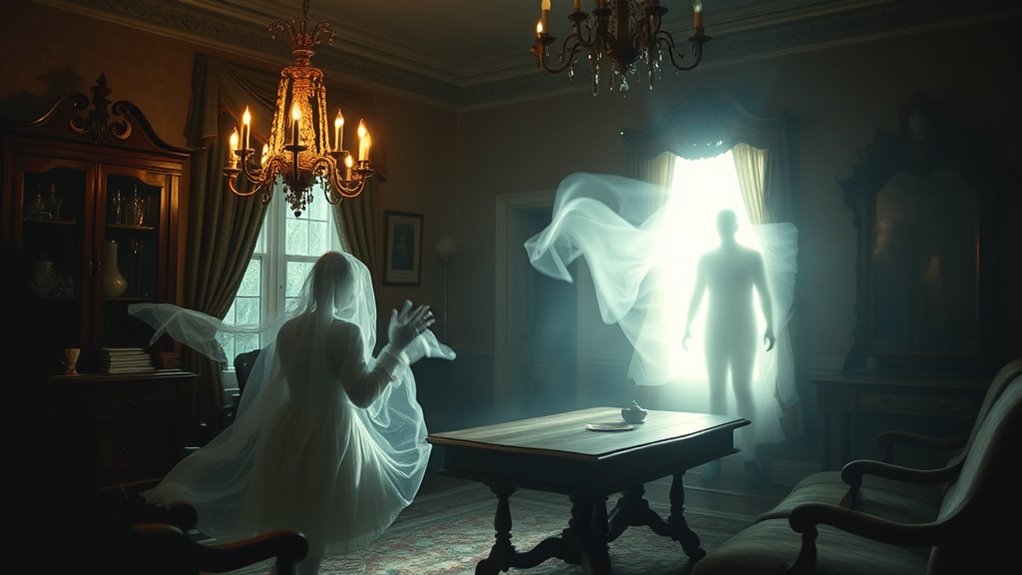
Various theories and explanations have been proposed to account for the poltergeist activity at Rosenheim. Some suggest that psychological phenomena, like mass hysteria or subconscious impulses, could explain the disturbances. Others point to environmental factors, such as electromagnetic interference or structural vibrations, influencing the events. To understand better, consider these possibilities: 1. Psychological phenomena, including stress or repressed emotions, might trigger physical manifestations. 2. Environmental factors, like faulty wiring or magnetic fields, could cause the unusual activity. 3. Skeptics argue that deliberate hoaxes or misinterpretations may be responsible for the phenomena. 4. The presence of electromagnetic interference can disrupt normal perceptions and induce unexplained disturbances. Additionally, recent advancements in AI technology have shown that electromagnetic signals can be manipulated to create illusions, which might offer a new perspective on such unexplained events. Researchers have also explored psychological triggers as a potential explanation for the phenomena. A comprehensive understanding of psychological phenomena and environmental influences remains crucial in unraveling these mysteries. Furthermore, scientific investigations into electromagnetic fields have provided insights into how these forces can affect human perception and behavior. While no single explanation fully accounts for everything, these theories highlight the complex interplay between mind and environment in such unexplained events.
Ongoing Impact and Significance
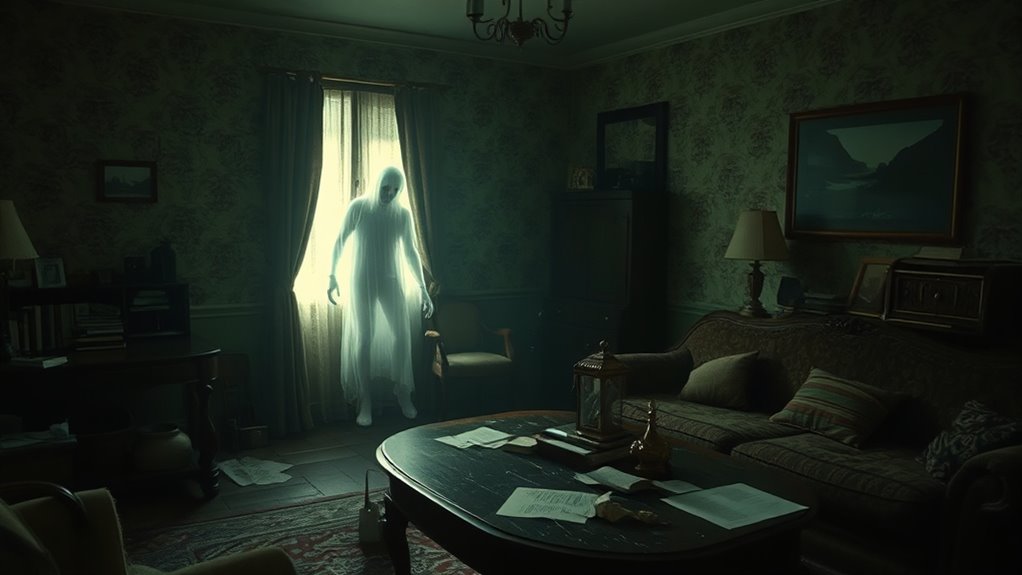
The Rosenheim poltergeist continues to influence both popular culture and scientific inquiry, highlighting its enduring significance. Its mysterious events provoke curiosity and debate, shaping how people interpret unexplained phenomena. It also raises questions about psychological perception, demonstrating how individual and collective beliefs can influence the interpretation of strange occurrences. The psychological impact on those involved remains a key aspect, as it reveals how fear and belief can amplify or distort experiences. Culturally, the case underscores society’s fascination with the supernatural and the unknown, inspiring books, documentaries, and discussions. It challenges skeptics and believers alike, forcing experts to refine their approaches to investigating such disturbances. The ongoing interest demonstrates that cases like Rosenheim’s aren’t just historical curiosities—they continue to inform our understanding of human perception, the power of suggestion, and the cultural importance we assign to inexplicable events. Additionally, analyzing the case can help improve investigation methods by applying scientific principles to better understand such phenomena. Recognizing the psychological factors involved can lead to more accurate assessments of similar cases in the future.
Frequently Asked Questions
Were There Any Similar Poltergeist Cases in Nearby Regions?
You might find that other nearby regions have similar poltergeist cases influenced by regional legends and folklore. These stories often reflect local cultural beliefs and superstitions, shaping mysterious events. You could explore folklore influences in places like Bavaria or Austria, where legends of spirits and hauntings are common. Such cases share common themes, showing how regional legends inspire and shape poltergeist phenomena across different areas.
What Was the Long-Term Psychological Impact on Witnesses?
Did you know 60% of witnesses in poltergeist cases experience lasting psychological trauma? You might find that, over time, many witnesses demonstrate remarkable resilience, adapting and recovering from their experiences. However, some suffer long-term anxiety or fear, impacting daily life. Your psychological resilience can vary greatly depending on individual circumstances, support systems, and personal coping strategies, highlighting the importance of mental health care after such intense paranormal encounters.
Did Any Experts Dismiss the Events as Hoaxes?
You might wonder if any experts dismissed the events as hoaxes. Scientific skepticism plays a role here, as some specialists questioned the authenticity of the phenomena. Expert testimonies vary; while some dismissed it as a deliberate deception or natural explanation, others remained open-minded. Overall, skepticism persisted among certain professionals, emphasizing the need for rigorous investigation before accepting extraordinary claims as genuine.
How Did Media Coverage Influence Public Perception?
You see, media sensationalism, public skepticism, and sensational headlines all shape how people perceive strange events. When the media exaggerates or dramatizes stories, you might find yourself more convinced or more doubtful. This constant cycle influences public perception profoundly, making you question the authenticity of the phenomena. As a result, media coverage can either fuel belief or deepen skepticism, depending on how the story is presented.
Are There Modern Reports of Similar Phenomena Today?
You might find modern reports of ghostly disturbances intriguing, as many claim to experience similar phenomena today. Paranormal investigations often explore these accounts, seeking evidence of unexplained activity. While skepticism remains, some believe that these reports reflect genuine paranormal activity. If you’re curious, you can follow recent investigations and witness accounts, which continue to fuel discussions about the existence of ghosts and the possibility of paranormal phenomena in our contemporary world.
Conclusion
As you reflect on the Rosenheim Poltergeist, you’re caught between skepticism and wonder, questioning whether these events are purely supernatural or rooted in human psychology. The quiet town’s peaceful facade contrasts sharply with the chaos inside the police station, highlighting how the extraordinary can lurk beneath the mundane. Ultimately, whether real or illusion, the case leaves you pondering the thin line between reality and the unknown, forever blurring the boundaries of what’s possible.
